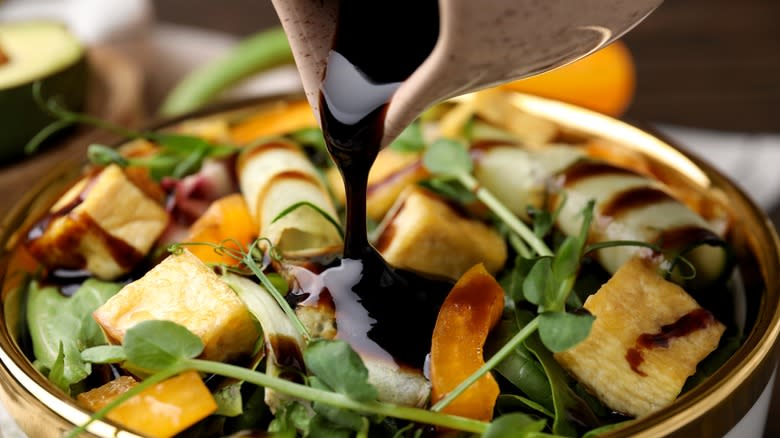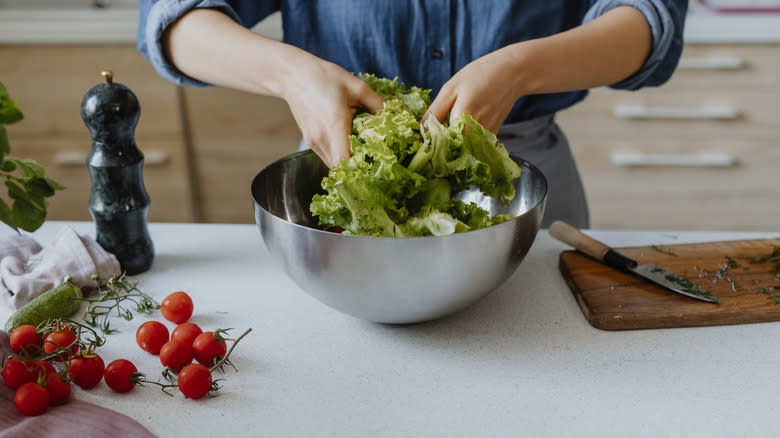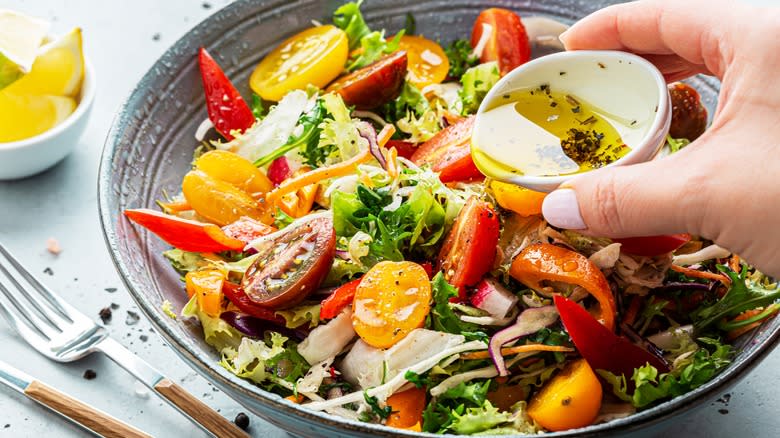The Proper Way To Dress A Salad So It's Perfect Every Time

You've washed and chopped the perfect leafy greens, sliced and diced accompanying fresh vegetables or fruits, and found the perfect nuts, croutons, or other crunchy bits for toppings. But you don't want to sully all that hard work constructing a beautiful salad by lazily dumping dressing on top and calling it a day. When you mindlessly add a vinaigrette, your bright, crisp salad can quickly go from delightful and scrumptious to drab and soggy.
In cooking, less is more, and adding dressing to your salad is no different. The best way to avoid drowning your meal in sauce is to toss the salad as you pour in the dressing. This method gradually adds liquid to your leaves so you can take a taste and assess how much more it really needs. It can be easy to start shaking a bottle of any popular salad dressing out onto the top of your dish only to find most of it collecting in a pool at the bottom of the bowl. By adding the dressing in layers, you avoid wasting it and over-soaking your greens.
Read more: The Best Grocery Store In Every State
Using Oil And Vinegar And Tossing Your Salad

If you've decided to keep your salad simple with just oil and vinegar, you'll want to add them in a specific order. When you see greens start to turn damp and brown, this means the outer waxy cuticle has broken down, and the leaves' inherent moisture is seeping out. Oil easily wilts greens by breaking through this waxy layer, while vinegar doesn't. So, as long as you add vinegar to your salad greens first, it'll act as a protective layer so the oil doesn't seep through and turn the leaves into mush. And again, remember to add your vinegar and oil gradually so you have control of the flavor balance.
While you're tossing your salad along the way, it may be smart to ditch the tongs. Salad tongs can often bruise lettuce, potentially damaging the aforementioned waxy cuticle that protects your greens from moisture loss. Instead, get down and dirty with your leaves by using your hands to evenly toss the salad.
The Best Method For Constructing A Salad Dressing

While bottled dressing is sufficient and works well in a pinch, you can make a homemade salad dressing in a flash. Just like with the greens, don't add your oil to your dressing container or jar first. Your vinegar and salt/pepper should go in first, with the oil last to help bring the ingredients together. Oil is hydrophobic, making it not very soluble with vinegar. If the oil goes in first, the vinegar and other ingredients will mostly sit on top instead of mixing with the oil. Adding it last will help bind the dressing ingredients as you shake it all up.
If you've made a dressing and find it starts to separate, there's an easy trick to fix a broken vinaigrette. Add in an emulsifying ingredient to thicken the dressing back up. Mustard, honey, cheese, and even miso are great examples of emulsifiers. These ingredients will help bring your oils and water-based ingredients together, ensuring the oil and vinegar properly combine to create your dressing concoction. In doing so, your salad will also get an even coating of the whole dressing. Just make sure to apply it in layers, taste-testing and assessing as you go, so you don't over or underdress your salad.
Read the original article on Daily Meal

